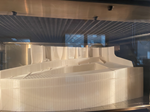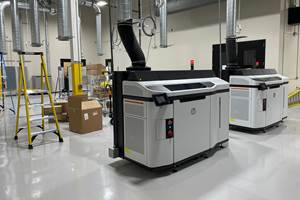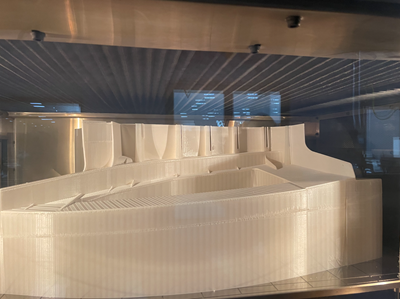As with any other type of machine that involves moving parts, 3D printers deal with vibration. But users often don’t recognize how much of an impact vibration has on their machines. “When you ask people, ‘Does your machine vibrate?’ they’ll say no,” says University of Michigan mechanical engineering professor Chinedum Okwudire. This is because machine vibration has an easy solution. “You just slow down and you don’t see vibration anymore,” he explains. “That’s why it’s actually a hidden problem.”
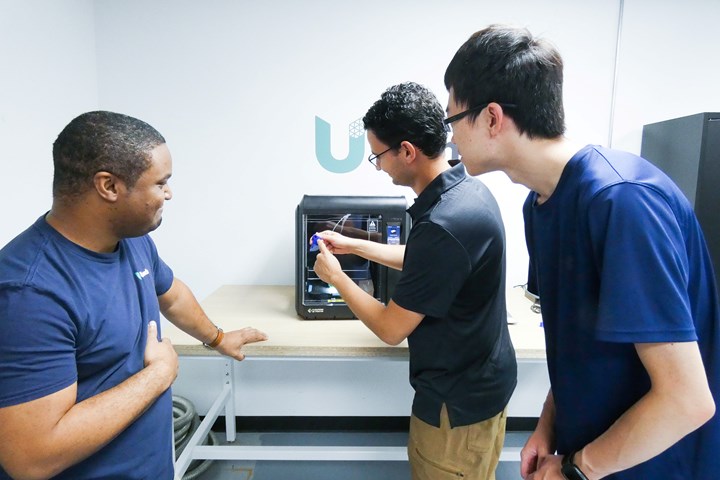
As the gantry and nozzle of an FFF 3D printer moves, it causes vibration that can compromise print quality. The easiest and most common way to counteract this issue is to slow down the machine, but this comes at the expense of print speed. Photo Credit: Ulendo
This means machines aren’t reaching their full potential. “People have not tried to push their machines to the limit,” he notes. “They just take the default parameters and say, ‘That’s the speed I’m supposed to use.’” OEMs can make other adjustments to their machines to counteract the effects of vibration and enable increased speed. Damping can help reduce vibration, but it adds mass, requiring more energy to run the machine and increasing wear and tear. Machines can also be made of stiffer materials, but OEMs have reached the limits of what they can do to design their machines to deal with vibration.
Welcome! You’ve unlocked premium content.
“People have not tried to push their machines to the limit. They just take the default parameters and say, ‘That’s the speed I’m supposed to use.’”
Okwudire studied the effects of vibration in machine tools while earning his PhD, and encountered the issue again when working for machine tool builder DMG MORI. “That's where the idea came to consider using software to compensate for vibration so that we can speed up the machines without sacrificing the quality of the parts that we're making,” he says.
When Okwudire joined the University of Michigan, he started researching how software could be used to compensate for machine tool vibration, eventually developing an algorithm called Filtered B Splines, or FBS. At the suggestion of one of his students, he applied the algorithm to 3D printers. “3D printers are close to our wheelhouse because they are manufacturing machines,” he notes. As they looked into FFF 3D printing, they saw quality issues that could be caused by vibration. And when they applied FBS to an FFF 3D printer, they were able to double the speed of the machine without compromising part quality or changing the machine’s hardware.
Okwudire has founded a company called Ulendo to make FBS available to the manufacturing industry. Beyond 3D printing, the algorithm is applicable to subtractive machine tools and robotics, but the company is focusing on FFF 3D printing as its entry point into manufacturing.
Vibration Compensation
3D printers, like robots and other machine tools, work by sending motion commands to the machine or equipment. FBS “tricks” the machine and modifies the motion commands based on how the machine vibrates. “Say you want the machine to travel straight, but due to vibration, it veers upward,” Okwudire explains. “What FBS does is that it asks the machine to move downward.” The downward motion cancels out the upward vibration so the machine travels straight.
Before the software can be applied to a machine, it needs to be able to predict how the machine is going to vibrate. This is accomplished by measuring the machine’s vibration behavior and creating a model called a calibration map. “With that calibration map, we're able to predict how the machine vibrates without our algorithm, and then determine what we should do to compensate for that motion,” Okwudire says. For 3D printers, this is a one-time process. For example, a 3D printer manufacturer would send one machine to Ulendo. The company then creates a calibration map of the machine, which can be deployed on all machines of that make and model.
After the calibration map is created, FBS is installed within the printer’s firmware (the software that controls the machine’s motors), and this is where all of the compensations are made — not in the G code. “It takes in the original commands, and then it modifies them and sends those modified commands down to the motors of the 3D printer,” Okwudire explains.
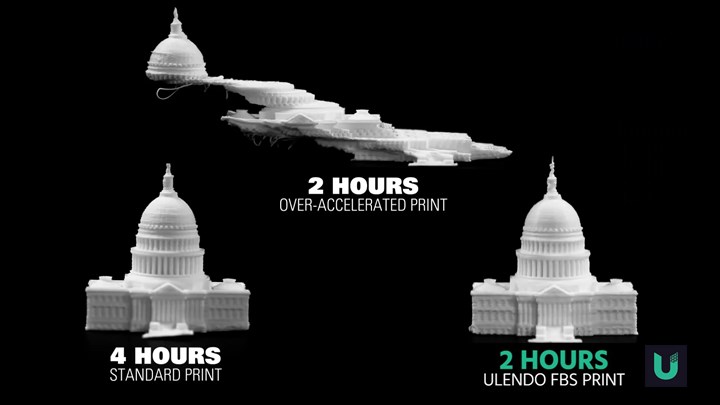
Ulendo’s FBS software predicts the vibration of a 3D printer and modifies motion commands to compensate for this vibration. This enables users to run FFF machines twice as fast while maintaining part quality. Photo Credit: Evan Dougherty, University of Michigan
Faster Print Times
For the first test, the team printed a scale model of the US Capitol on what Okwudire describes as a “low-cost desktop printer.” Results showed that FBS reduced print time by 50%, from four hours to two, without impacting quality. These results (doubled print speed) have been consistent across multiple brands of FFF printers, including what would be considered “higher end” models. “It doesn't surprise me because I worked in an industry that manufactures high end machines and I knew that those machines had vibration problems,” he says. “It’s not a low-cost machine problem. It is a problem that is shared across the board at different levels.”
Faster print speeds means higher throughput, which could translate to a number of benefits. For example, “We've spoken to people who say they have to buy a second or a third printer just to keep up with the demands,” Okwudire says. But if their existing printer can produce parts twice as fast, they won’t need to add more machines as frequently.
It could also open up new business opportunities for on-demand printing. For example, say there’s a kiosk that scans a person’s feet and prints custom insoles. If it ordinarily takes four hours to print the insoles, that’s half the day. But if FBS reduces the print time to two hours, that’s much more feasible for on demand manufacturing. Customers could finish their shopping and come back to pick up their insoles. “Four hours to two hours can make a big difference in in the production value or the end benefit of 3D printing in a particular industry taking off or not,” Okwudire notes.
Beyond FFF
Although Ulendo is starting with FFF 3D printing, the technology is applicable to many different manufacturing applications. “FBS is agnostic to the actual process that is happening at the end,” Okwudire says. “It makes whatever you’re doing more capable.”
This includes other 3D printing processes, such as directed energy deposition (DED). “I would expect more or less the same results for DED because the machines carry heavy masses that move quite aggressively,” he notes. “So I think the vibration problem is equally as bad.” FBS could also be applied to powder bed fusion (PBF), particularly machines that use a gantry to drive the lasers, because they’re relatively similar to FFF, though it could also possibly benefit PBF machines that use mirrors.
Outside of 3D printing, FBS could also be applied to machine tools, which have a similar platform to FFF printers. However, these machines have the added factor of cutting forces. During roughing passes, where the machine tool is removing a lot of material, the cutting forces work against the vibration, and accuracy and surface finish are less important at this stage. But during finishing passes, where small amounts of material are being removed, cutting forces are lower and the machine tool can start to leave vibration marks on the part that affect the surface finish. FBS could improve speed and part quality in these applications.
Robotics is another area that Ulendo is closely investigating. This would be more complex than a 3D printer because a 3D printer gantry’s “payload” (the nozzle) is constant, and the motion is limited. A robot’s vibration changes depending on the motion and the payload, plus it has more axes of motion, so the team is working on a version of FBS where the calibration map changes as these factors change. Similar to 3D printers and machine tools, FBS could allow robots to move faster, but it could also allow collaborative robots to handle heavier payloads.
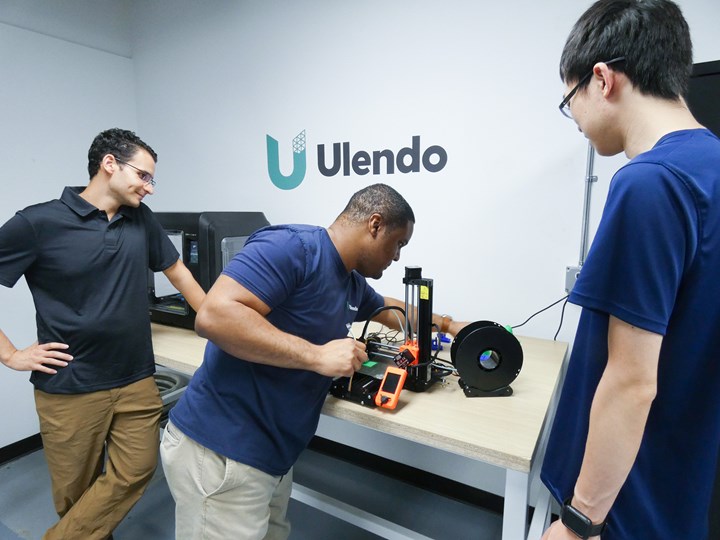
Ulendo is currently working with FFF 3D printer OEMs to introduce FBS to the manufacturing industry. Eventually, it plans to offer the software as an aftermarket option for 3D printers, as well as apply it to other types of equipment, including DED, robots and machine tools. Photo Credit: Ulendo
New Machine Possibilities
Okwudire says that a major opportunity for FBS is how it could enable new machine designs and configurations. When machine OEMs don’t have to be so concerned with designing machines to reduce vibration, it opens new possibilities such as machines with smaller belts and motors. “You could have lower cost 3D printers or robots that are more capable,” Okwudire says. “It will open up precise 3D printing to a different class of people who might benefit from these machines.” There’s also the potential to add more functionality to machines. For example, FFF 3D printers could have multiple nozzles without sacrificing print speed.
In the short term, however, Ulendo is working with 3D printer OEMs to add FBS to machines. “We decided as a company for efficiency’s sake to start with 3D printer manufacturers,” says CEO Brenda Jones. It recently announced that Flashforge is including FBS on two of its printers. One, the Adventurer 4, is Flashforge’s best-selling desktop printer, and the other, the Creator 4, is a new industrial model, so Ulendo will get exposure to both the maker and industrial 3D printing spaces. The company is in the process of onboarding the software onto the printers, and hopes that they’ll be available by the end of the year. Longer term, Ulendo plans to offer FBS as an aftermarket option for a variety of machines. “There are millions of printers already out there this could help,” Jones notes.
Related Content
Copper, New Metal Printing Processes, Upgrades Based on Software and More from Formnext 2023: AM Radio #46
Formnext 2023 showed that additive manufacturing may be maturing, but it is certainly not stagnant. In this episode, we dive into observations around technology enhancements, new processes and materials, robots, sustainability and more trends from the show.
Read MoreWhat Does Additive Manufacturing Readiness Look Like?
The promise of distributed manufacturing is alluring, but to get there AM first needs to master scale production. GKN Additive’s Michigan facility illustrates what the journey might look like.
Read More3D Printed Spine Implants Made From PEEK Now in Production
Medical device manufacturer Curiteva is producing two families of spinal implants using a proprietary process for 3D printing porous polyether ether ketone (PEEK).
Read More3D Printing with Plastic Pellets – What You Need to Know
A few 3D printers today are capable of working directly with resin pellets for feedstock. That brings extreme flexibility in material options, but also requires greater knowledge of how to best process any given resin. Here’s how FGF machine maker JuggerBot 3D addresses both the printing technology and the process know-how.
Read MoreRead Next
What Is Material Extrusion 3D Printing?
Material extrusion extrudes material through a nozzle and selectively deposits it layer-by-layer to form an object. After three decades of material advancements and a diverse array of start-ups and applications, the use cases for this technology are still going strong.
Read MoreVibration Compensation Could Increase Use of Robots for 3D Printing
Ulendo is working to apply its vibration compensation algorithm for FFF 3D printers to robots, which could expand the use of robots for 3D printing.
Read MoreUlendo and Rev1 Technologies Collaborate on Software Upgrade That Increases Speed of Industrial Extrusion-Based Printers
Formnext 2024: For the CreatBot F430, Rev1 is offering the Ulendo VC vibration compensation software upgrade which is said to quintuple the speed of FFF 3D printers while maintaining part quality, all without changing the machine’s hardware.
Read More


